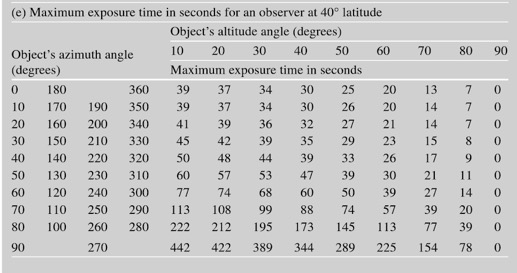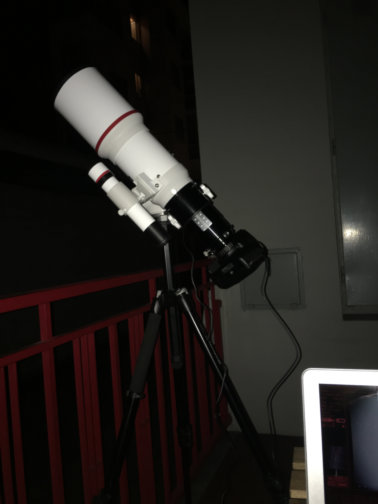Field rotation can really be considered the bogeyman of DSO astrophotography with altazimuth mounts, indeed all those who object to the possibility of doing any serious AP with AltAz mounts invariably quote it as THE main obstacle.
So, what is it and why is it so bad for altazimuth astrophotography?
It has been explained a number of times on books and on the Internet, however, for ease of exposition, I will repeat it here once more and send you here for a more visual representation.
From the Celestron site :
Field rotation is the apparent rotation of a celestial object in the field of view of a telescope during the course of the night. All objects in the eyepiece field or on the camera’s image will move in arcs.
It happens when you are using an altazimuth mount or a misaligned equatorial mount. In these cases, all the stars will appear to move around the point or star that is being tracked.
Field rotation can be visualized by thinking about what happens when a constellation or the moon rises, transits and sets. From northern latitudes, Orion will rise on his side with his left shoulder (the one north of Rigel) highest. As he crosses the sky he will reach and transit the meridian, when both shoulders will be the same height. When he sets, the right shoulder (Betelgeuse) will appear highest. It’s like he’s climbed the dome of the sky, reaching the top and then goes down the other side. The angle of his body changes during the course of the night, first tilting to the east, then tilting to the west.
On photos, even if tracking on a star is perfect, unless the mount itself is perfectly polar aligned, there will be some degree of field rotation. Only the center will show pinpoint stars or sharp detail. Towards the edge of the field of view, all stars will show arcs concentric with the center.
Because of field rotation, no altazimuth mount is suitable for long-exposure astrophotography.
It is all correct in line of principle, but … how really “long” is that long-exposure astrophotography that is forever forbidden to users of AltAz mounts?
Or, if you prefer, how long an exposure can be taken with an AltAz mount without showing the dreaded effects of field rotation?
The best and most complete mathematical treatment I know of can be found in Michael Covington’s “Astrophotography for the Amateur”, but an in depth one can also be found online here, while more practical approaches, with tables of allowed exposure times, can be found in Ashley and also on various Internet sites.
Essential factors to determine the longest exposure possible with an AltAz mount are the altitude (the lower the better) and the azimuth (the closer to East or West the better) of the subject you want to image.
The worst possible locations (forcing you to exposures of less than 15s) are close to the zenith and to the South and North, while the best ones are close to the horizon, due East and due West, where you could theoretically image for up to ten minutes without noticeable signs of field rotation.
Field rotation is also dependent on the location on Earth of the observer and particularly on its latitude with a maximum for an observer located on the earth’s equator and a minimum, zero, for an observer located at the Earth’s poles where the zenith and the celestial pole obviously coincide.
While the mathematical analysis of the problem shows that it is independent from the focal length used, it is instead quite dependent on the size of the sensor: the smaller the better.
It is indeed quite logical that since rotation happens around a central pivotal point (that of perfect tracking), the farther you move away from that point, the longer are the curved streaks or arcs induced by field rotation. And it is also quite obvious that the bigger the sensor, the farther you can travel from that point.
For instance, as one can read in Ashley , for an APS-C sensor acceptable exposure times at a 40 degree latitude are as follows:

While for a Meade DSI at the same latitude, the values we find here are more generous:

For instance, in the highly unfavorable case of an altitude of 70° due North or South (0° or 180° of azimuth), with an APS-C sensor (diagonal of about 27 mm) you are limited to a maximum exposure time of 13s, while with the 6 mm diameter sensor of the Meade DSI you can go up to 30s.
This also means that if you are careful to put your subject as close as possible to the geometric center of the bigger sensor and then crop the pics you get, and keep only an area equivalent to the smaller sensor, you can effectively use the maximum exposure time allowed for the smaller sensor.
Anyways, even using the full width of an APS-C sensor, one can take (at a 40° latitude) exposures of 60s or more from twenty degrees before to twenty degrees after due East or due West up to an altitude of 60°.
Often the real limit is in the tracking capability of the mount, rather than in field rotation, especially if one considers that if the latter does not vary with focal length, the former does.
Even in a situation allowing you a relatively long exposure time, there are two more drawbacks to altazimuth AP with respect to classical equatorial AP.
One is that the pics you stack move with respect to one another to form a sort of “fanned stack” in which the useful area, common to all the pics is always smaller than the area of a single light frame and indeed smaller and smaller as the integration time increases, as shown in this other interesting site.

Indeed if one wishes to achieve a quite long integration time without “squeezing” the useful area too much, the use of light frames from different nights becomes unavoidable.
The second drawback is due to the fact that, even if star trailing due to field rotation is not noticeable in a 30 seconds exposure, the subject is indeed nevertheless “rotating” a bit in those 30 seconds and this may produce individual light frames which are “softer” than light frames with the same exposure time taken from a perfectly polar aligned equatorial mount.
To all that one may add that computerized AltAz mounts track with a sort of zigzag motion in both altitude at azimuth that may in itself add some blur to the image.
In the end it is clear that altazimuth AP cannot achieve the best results achievable by conventional AP with the use of equatorial mounts and of autoguiding: I do not pretend to have just reinvented the wheel.
What I do instead think altazimuth AP can do is achieving a cost/benefit ratio essentially on par with conventional equatorial AP, that is you spend one tenth of the money to obtain one tenth of the quality, or one fifth of the money to achieve one fifth of the quality, and so on.
Indeed you usually get even better than that, because, as in everything in life, there is a law of diminishing returns in force also in astrophotography: when you spend twice to improve your equipment, you do not get twice better results, and indeed the more you get spending, the more the curve representing the improvement in quality becomes logarithmic.
